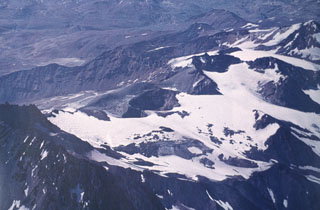Report on Planchon-Peteroa (Chile) — 16 July-22 July 2025
Smithsonian Institution / US Geological Survey
Weekly Volcanic Activity Report, 16 July-22 July 2025
Managing Editor: Sally Sennert.
Please cite this report as:
Global Volcanism Program, 2025. Report on Planchon-Peteroa (Chile) (Sennert, S, ed.). Weekly Volcanic Activity Report, 16 July-22 July 2025. Smithsonian Institution and US Geological Survey.
Planchon-Peteroa
Chile
35.223°S, 70.568°W; summit elev. 3977 m
All times are local (unless otherwise noted)
The Servicio Nacional de Geología y Minería (SERNAGEOMIN) reported that seismicity increased at Planchón-Peteroa during 13-15 July according to the Observatorio Volcanológico de los Andes del Sur (OVDAS). Beginning in March there was an increase in low-magnitude (mostly less then M2), volcano-tectonic events. On 19 June a tremor pulse was detected that had deep-source characteristics. Earthquakes associated with internal fluid movement began to be recorded on 13 July, though the events were low energy and occurred at a low rate. Seismicity increased at 0800 on 15 July and consisted of long-period (LP) earthquakes and tremor pulses. From 13 July to 1640 on 16 July the network recorded more than 1,200 low-energy seismic events and there was a shift to more LP-type seismicity. On 18 July the Alert Level was raised to Yellow (the middle level on a three-color scale) and the public was warned to stay 2 km away from the center of the active craters. The Sistema y Servicio Nacional de Prevención y Repuesta Ante Desastres (SENAPRED) stated that the communities of Molina (66 WNW), Curicó (68 km NW), Romeral (75 km NW), and Teno (68 km NW) were placed under “Preventive Early Warning” and that only residents were allowed within a 4 km radius of the craters.
Geological Summary. Planchón-Peteroa is an elongated complex volcano along the Chile-Argentina border with several overlapping calderas. Activity began in the Pleistocene with construction of the basaltic andesite to dacitic Volcán Azufre, followed by formation of the basaltic and basaltic andesite Volcán Planchón, 6 km N. About 11,500 years ago much of Azufre and part of Planchón collapsed, forming the massive Río Teno debris avalanche, which traveled 95 km to reach Chile's Central Valley. Subsequently, Volcán Planchón II was formed. The youngest volcano, andesitic and basaltic andesite Volcán Peteroa, consists of scattered vents between Azufre and Planchón, and and contains a small steaming crater lake. Reported eruptions from the complex have been dominantly explosive, although lava flows were emplaced in 1837 and 1937.
Sources: Servicio Nacional de Geología y Minería (SERNAGEOMIN), Sistema y Servicio Nacional de Prevención y Repuesta Ante Desastres (SENAPRED)

